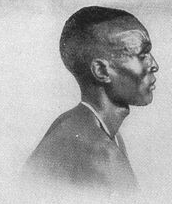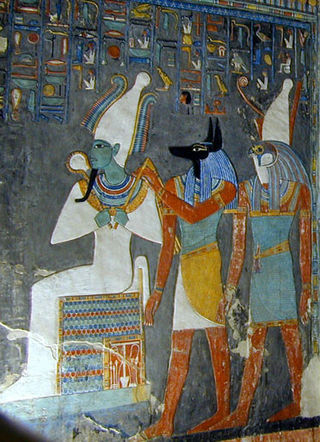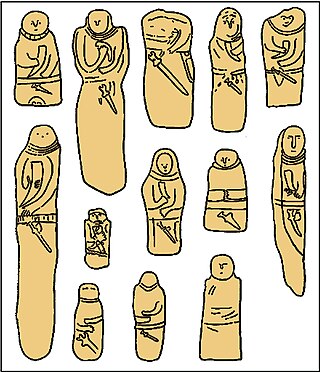Related Research Articles
The Nilotic peoples are people indigenous to the Nile Valley who speak Nilotic languages. They inhabit South Sudan, Sudan, Egypt, Ethiopia, Uganda, Kenya, the Democratic Republic of the Congo, Rwanda, Burundi and Tanzania. Among these are the Burun-speaking peoples, Karo peoples, Luo peoples, Ateker peoples, Kalenjin peoples, Datooga, Dinka, Nuer, Atwot, Lotuko, and the Maa-speaking peoples.
Dinka spirituality is the traditional religion of the Dinka people, an ethnic group of South Sudan. They belong to the Nilotic peoples, which is a group of cultures in Southern Sudan and wider Eastern Africa. The Dinka people largely rejected or ignored Islamic teachings, as Abrahamic religious beliefs were incompatible with their society, culture and traditional beliefs.

The Dinka tribe are a Nilotic ethnic group native to South Sudan with a sizable diaspora population abroad. The Dinka mostly live along the Nile, from Jonglei to Renk, in the region of Bahr el Ghazal, Upper Nile, and the Abyei Area of the Ngok Dinka in South Sudan.

The Canaanite religion was the group of ancient Semitic religions practiced by the Canaanites living in the ancient Levant from at least the early Bronze Age through the first centuries AD. Canaanite religion was polytheistic and, in some cases, monolatristic. Some gods and goddesses were absorbed into the Yahwist religion of the ancient Israelites, notably El, Baal and Asherah, until the Babylonian captivity where they worshipped Yahweh alone.
Abuk is the first woman in the myths of the Dinka people of South Sudan and the Nuer of South Sudan and Ethiopia, who call her Buk or Acol. She is the only well-known female deity of the Dinka. She is also the patron goddess of women as well as gardens. Her emblem or symbols are, a small snake, the moon and sheep. She is the mother of the god of rain and fertility (Denka). The story from her birth to marriage and child-birth is:
::She was born very small, when placed in a pot, she swelled like a bean.

Hittite mythology and Hittite religion were the religious beliefs and practices of the Hittites, who created an empire centered in what is now Turkey from c. 1600–1180 BC.

The sky often has important religious significance. Many religions, both polytheistic and monotheistic, have deities associated with the sky.

Ancient Egyptian deities are the gods and goddesses worshipped in ancient Egypt. The beliefs and rituals surrounding these gods formed the core of ancient Egyptian religion, which emerged sometime in prehistory. Deities represented natural forces and phenomena, and the Egyptians supported and appeased them through offerings and rituals so that these forces would continue to function according to maat, or divine order. After the founding of the Egyptian state around 3100 BC, the authority to perform these tasks was controlled by the pharaoh, who claimed to be the gods' representative and managed the temples where the rituals were carried out.

The Scythian religion refers to the mythology, ritual practices and beliefs of the Scythian cultures, a collection of closely related ancient Iranian peoples who inhabited Central Asia and the Pontic–Caspian steppe in Eastern Europe throughout Classical Antiquity, spoke the Scythian language, and which included the Scythians proper, the Cimmerians, the Sarmatians, the Alans, the Sindi, the Massagetae and the Saka.
Deng, also known as Denka, is a sky, rain, and fertility god in Dinka mythology for the Dinka people of Sudan and South Sudan. He is the son of the goddess Abuk.
Ronald Godfrey Lienhardt was a British anthropologist. He took many photographs of the Dinka people he studied. He wrote about their religion in Divinity and Experience: the Religion of the Dinka.

A deity or god is a supernatural being who is considered divine or sacred. The Oxford Dictionary of English defines deity as a god or goddess, or anything revered as divine. C. Scott Littleton defines a deity as "a being with powers greater than those of ordinary humans, but who interacts with humans, positively or negatively, in ways that carry humans to new levels of consciousness, beyond the grounded preoccupations of ordinary life".

The Dinka–Nuer West Bank Peace & Reconciliation Conference of 1999 was held in what was then the Southern part of Sudan. It is commonly called the "Wunlit Peace Conference" after Wunlit, the village where it was held in eastern Tonj County in Bahr El Ghazal. The conference brought together Nuer from Western Upper Nile and Dinka from Tonj, Rumbek, and Yirol. It is the most prominent and comprehensively documented case of a people-to-people peace process in what is now the Republic of South Sudan.
Kwoth, also known as Kwoth Nhial, is in African mythology the supreme omnipresent god and creation god of the Nuer people of South Sudan.
References
- 1 2 3 4 5 6 7 8 9 Johnston, R. T. (1934). "The Religious and Spiritual Beliefs of the Bor Dinka". Sudan Notes and Records. 17 (1): 124–128. ISSN 0375-2984. JSTOR 41716073.
- 1 2 "Encyclopedia of African Religion". SAGE Publications Inc. 2021-03-22. Retrieved 2021-03-23.
- 1 2 3 4 Lynch, Patricia Ann; Roberts, Jeremy (2010). African Mythology, A to Z. Infobase Publishing. ISBN 978-1-4381-3133-7.
- ↑ Pendle, Naomi R. (2018-01-09). "'The dead are just to drink from': recycling ideas of revenge among the western Dinka, South Sudan". Africa. 88 (1): 99–121. doi: 10.1017/S0001972017000584 . ISSN 0001-9720.
- 1 2 3 4 5 6 7 8 9 Lienhardt, Godfrey (1961-01-01). Divinity and Experience : The Religion of the Dinka: The Religion of the Dinka. Oxford University Press, UK. ISBN 978-0-19-159185-3.